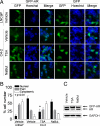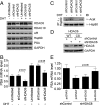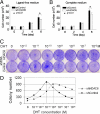HDAC6 regulates androgen receptor hypersensitivity and nuclear localization via modulating Hsp90 acetylation in castration-resistant prostate cancer
- PMID: 19855091
- PMCID: PMC2796151
- DOI: 10.1210/me.2009-0188
HDAC6 regulates androgen receptor hypersensitivity and nuclear localization via modulating Hsp90 acetylation in castration-resistant prostate cancer
Abstract
The development of castration-resistant prostate cancer (PCa) requires that under castration conditions, the androgen receptor (AR) remains active and thus nuclear. Heat shock protein 90 (Hsp90) plays a key role in androgen-induced and -independent nuclear localization and activation of AR. Histone deacetylase 6 (HDAC6) is implicated, but has not been proven, in regulating AR activity via modulating Hsp90 acetylation. Here, we report that knockdown of HDAC6 in C4-2 cells using short hairpin RNA impaired ligand-independent nuclear localization of endogenous AR and inhibited PSA expression and cell growth in the absence or presence of dihydrotestosterone (DHT). The dose-response curve of DHT-stimulated C4-2 colony formation was shifted by shHDAC6 such that approximately 10-fold higher concentration of DHT is required, indicating a requirement for HDAC6 in AR hypersensitivity. HDAC6 knockdown also inhibited C4-2 xenograft tumor establishment in castrated, but not in testes-intact, nude mice. Studies using HDAC6-deficient mouse embryonic fibroblasts cells showed that inhibition of AR nuclear localization by HDAC6 knockdown can be largely alleviated by expressing a deacetylation mimic Hsp90 mutant. Taken together, our studies suggest that HDAC6 regulates AR hypersensitivity and nuclear localization, mainly via modulating HSP90 acetylation. Targeting HDAC6 alone or in combination with other therapeutic approaches is a promising new strategy for prevention and/or treatment of castration-resistant PCa.
Figures






References
-
- Huggins C 1967 Endocrine-induced regression of cancers. Science 156:1050–1054 - PubMed
-
- Grossmann ME, Huang H, Tindall DJ 2001 Androgen receptor signaling in androgen-refractory prostate cancer. J Natl Cancer Inst 93:1687–1697 - PubMed
-
- Culig Z, Hobisch A, Hittmair A, Peterziel H, Cato AC, Bartsch G, Klocker H 1998 Expression, structure, and function of androgen receptor in advanced prostatic carcinoma. Prostate 35:63–70 - PubMed
-
- Chang C, Saltzman A, Yeh S, Young W, Keller E, Lee HJ, Wang C, Mizokami A 1995 Androgen receptor: an overview. Crit Rev Eukaryot Gene Expr 5:97–125 - PubMed
-
- Huggins C, Hodges CV 1972 Studies on prostatic cancer. I. The effect of castration, of estrogen and androgen injection on serum phosphatases in metastatic carcinoma of the prostate. CA Cancer J Clin 22:232–240 - PubMed
Publication types
MeSH terms
Substances
Grants and funding
LinkOut - more resources
Full Text Sources
Other Literature Sources
Medical
Research Materials
Miscellaneous

